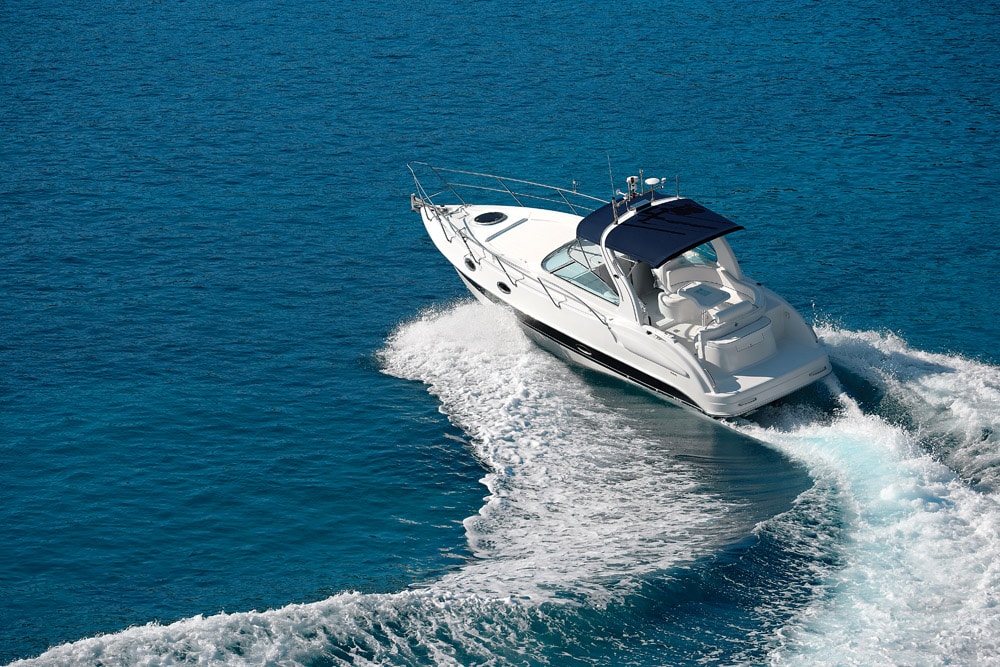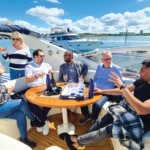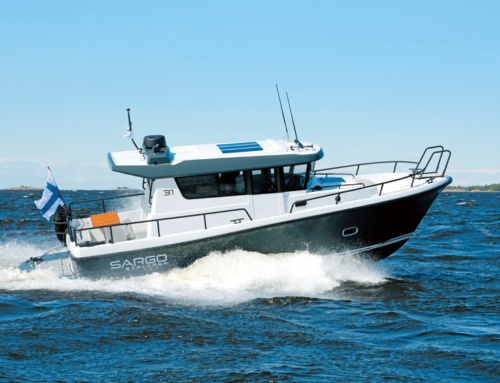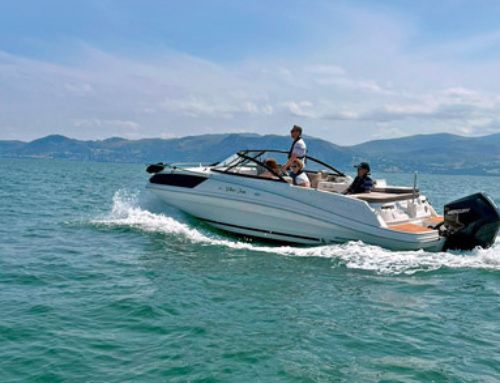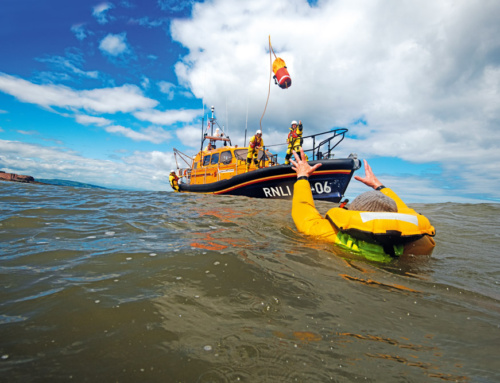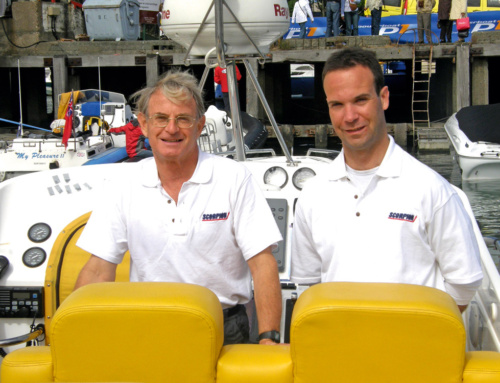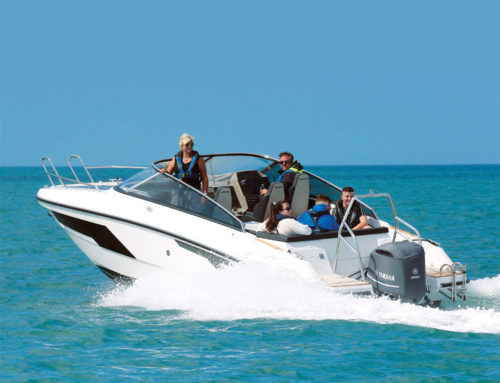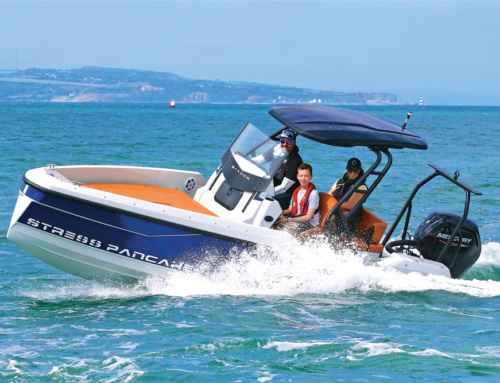PBR correspondent Malcolm Thomas, a professional charter boat skipper himself, provides valuable guidance and insight for would-be skippers, owners and guests on the benefits and attractions associated with motorboat charter.
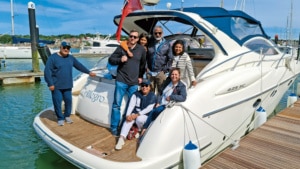
Flavian DSouza, an elected master of the most Honorable Company of Master Mariners with family.
High summer is ‘peak season’ for all those involved in the business of charter boats in the UK’s busy Solent. Besides established operators, there are those new to the fold too, and as a consequence the choice has never been greater for those wanting to hire a boat for a day out on the water. Demand is certainly high. According to one statistic from ResearchAndMarkets.com, ‘[t]he UK yacht charter market will grow to just under one billion GBP by 2027, at a compound annual growth rate of 6.11%’. Such figures are impressive by anyone’s standard.
Speaking as a professional within the charter industry myself, I’m of the opinion that the pandemic provided a boost to the UK charter industry. Of course, overseas travel was very restricted over this period, which prompted many to look closer to home for activities, including boat charter. Perhaps not surprisingly, a good number of folk were first-time motorboat charterers. The sailing charter market is long established, but one of the differences between power and sail is the fact that sailing craft are often chartered ‘bareboat’. There are large fleets of craft available from the likes of Sunsail and Fairview, as well as those offered by independently run clubs and sail training schools.
The powered option
Those that would fall within the ‘motor cruiser’ category in particular tend to be skippered charters. Owners and insurers are understandably a little more wary about letting someone with minimal experience get behind the wheel of, say, a 25-knot-plus 12-ton motor cruiser! Therefore, such charter vessels will come with a suitably qualified owner/skipper at the helm, or a professional skipper who’s employed by the owner of the vessel. Depending on the size of the boat, it may even include an additional crewmember or deckhand.
But for private owners of such craft, gaining even a moderate return on their investment with a view to helping to offset their vessel’s running costs can, of course, be attractive. With ever-increasing mooring fees, high fuel prices and maintenance costs, it can make a lot of sense for owners to try and recoup some of the expenses of boat ownership by means of a few charters. Additionally, a boat could even be purchased with the intention of professional charter work right from the off.
- Guests enjoying the sun on board
- Celebrating an engagement proposal on Allegro
- A guest having a go at the helm
Licensing and equipment
As you might expect, though, if you’re someone who might be interested in offering your boat for charter, you should be aware that there are rules that need to be complied with. This applies to the boat’s licensing (or ‘coding’) as well as the necessary skipper qualifications. In the UK, most craft operate under the MCA’s ‘small passenger vessel rules’, which allow up to 12 passengers and two crew on suitable vessels of up to 24m. Local authorities are also able to issue licences, but these tend to be restricted in area, whereas an MCA licence usually applies throughout UK coastal waters. There are various categories of sea areas – from A to D as defined in MSN 1776 (M) on the MCA website – and the licence and/or skipper’s qualifications will determine the distances they are able to operate from a safe haven.
While it’s a bit daunting at first, don’t despair, as all the regulations are available online. Simply start by googling ‘MGN280’, which is also on the Maritime and Coastguard Gov website (see info box below).
Info for the skipper
- https://www.gov.uk/government/collections/small-craft-codes-of-practice
- MGN 280 (M): Construction standards for small vessels in sport use.
- Categories of sea areas from A to D: these are listed in MSN 1776 (M)
- MSN 1874 Marine Equipment – United Kingdom.
- Information about Local Passenger Vessel Crew training arrangements is detailed in MGN 203; manning requirements are contained in MGN 290.
The good news is that the requirements for equipment to be carried on board are really what every seagoing boat should carry anyway and are pretty much the same for both local authority and MCA boat licensing. The full list can be found online on both the .gov and RYA websites (for the latter, see ‘pleasure craft regulations’). Maritime safety equipment suppliers such as Ocean Safety and ADEC Marine are also very helpful when sourcing safety equipment and will advise accordingly.
Here are a few examples, but by no means all, of the requirements:
- A life raft for the number of passengers and crew for which the vessel is licensed. These can be hired or purchased.
- The correct number of life jackets plus two spares for the number of passengers and crew carried. It’s also a good idea to have children’s life jackets and approved buoyancy aids and maybe even one for dogs.
- Flare packs designed for the operating area.
- Life rings with the name of the boat.
- An MCA Cat C first-aid kit and a ‘day kit’.
- Paper charts for the area even if a chartplotter is used.
- A VHF set with DSC (digital selective calling) for automated distress calls.
- A set of safety procedures for the boat with instructions for fire and in the event of distress, and a safety briefing must be provided to all passengers on arrival.
All equipment has to be functional, in date and inspected regularly. For most items, that’s usually annually or according to schedule.
Manning requirements and training
A skipper’s boat qualifications, in isolation, are not necessarily sufficient for the job in hand. This is because they have to be backed up with a number of other courses and qualifications in order to be commercially endorsed for paid work.
Various options are available when it comes to the matter of training. The RYA route is perhaps the most popular, and they can issue commercially endorsed certificates. STCW (International Convention on Standards of Training, Certification and Watchkeeping for Seafarers) courses are essential for anyone seeking work on a superyacht. Local authority boatmen certificates are also available with specific restrictions. With an RYA Powerboat Level 2 forming the basis, a skipper will also need a VHF certificate, a first-aid certificate and some form of legitimate sea survival training. An Eng1 or ML5 medical certificate from an MCA-approved doctor is required, and skippers will need to pass an online ‘Professional practices and responsibilities’ course. It all sounds quite onerous, but it’s thoroughly worthwhile, practical stuff, so don’t be put off. There are, of course, some great RYA training schools, particularly around the charter hub of the Solent.
Once all the courses and medicals are completed, the RYA can issue a commercially endorsed version of your original RYA boat qualification, allowing you to operate commercially within the restrictions of your qualification. Usually, these certificates are valid for five years for under 60s. Some courses, such as those that are first aid related, must be revalidated, and medicals must be renewed as required. There is an organisation called the ‘Professional Charter Association’ (PCA) that ensures standards are met by their members and promotes members and their interests. It’s not compulsory, but it’s well worth a look.
Good to go!
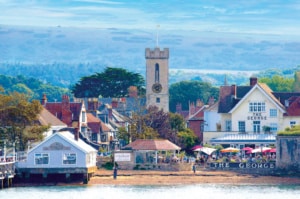
The George at Yarmouth – a pupular charter destination
Providing you’ve complied with all the rules and regs, the boat has been inspected, you’ve received your licence and you’ve upgraded your insurance and public liability, you’re in a position to get started. There are always more qualifications to be gained, but practice and experience count for so much.
Solent charter operators are a fairly close-knit bunch – the longer you are involved in the business, the more you’ll meet other operators. Andy Holmes, skipper of Lucky Ash, a 23m Princess, is a real character, as are David Ramos, skipper of Ramosseas, and Akis Zissis of Southampton and Portsmouth RIB Charter, to name but a few. All of these and many others are great operators, and it’s worth noting that charter people often share enquiries and skippers – plus, crew often work on a number of different boats. It’s something of a club.
Customer and tour guide skills
For all those contemplating the role of a charter skipper, good communication is essential before customers even come on board, as they need to be properly briefed so as to know what to expect and what’s expected of them. As you can imagine, clients range from families to company groups and private parties, and a skipper is responsible for the safety of all those aboard. The importance of safety has to be balanced with the need for clients to have fun, though. Many will enjoy a drink, and some may not be used to being out on a boat at all! But being approachable, friendly and confident in your delivery will put people at their ease and ensure that the right atmosphere exists on board. We have met some great people, we’ve had a US Navy F15 strike eagle pilot and family aboard, UK Airforce Chinook Pilots, army veterans, front line doctors and nurses and so many incredible people it’s been a privilege to meet.
Within my home cruising grounds of the Solent, like every skipper, I have my favourite, tried and trusted locations that I frequent. This is because I know, above all, they’ll be appreciated by my clients too. These include the tranquil waters of Newtown Creek, with its far-reaching views into the heart of the Isle of Wight’s green and gentle countryside. The seal population here is always a delight to see, and as you can imagine, guests just love the opportunity to see marine wildlife up close in their natural habitat. The scenic anchorage at Alum Bay is another favourite, as are the iconic Needles and their famous lighthouse. When folk experience that first opportunity to see the Needles’ mighty white chalk stacks up close, the tide ripping through the shallows and the beauty of the aquamarine water lapping at the boat’s hull, you realise you have the privilege of helping people make lifelong memories.
‘Drivers’
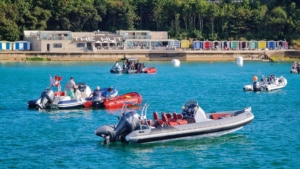
Boats at anchor at Colwell Bay for The Hut, and the restaurant tenders at work ferrying customers ashore.
It’s fair to say that the Solent charter market is driven in no small part by the popularity of two restaurants, ‘The George’ at Yarmouth and, in particular, ‘The Hut’ at Colwell Bay. The latter is hugely popular and is unique in that customers arriving by boat are taken ashore by the restaurant’s very own tenders. To put this into context, the WhatsApp group operated by The Hut’s tender skippers has about 40 professional members (that’s just the charter operators and does not include all the private boat owners). Tender skippers Russ and Fraser and their team do an incredible job ensuring that boats remain secure at anchor, as they ferry literally hundreds of passengers a day safely to and from the visiting craft anchored in Colwell Bay. Customers for The George can usually be dropped off in Yarmouth Harbour just behind the lifeboat, and here again, the harbour master’s team do such a great job handling all the busy on-water traffic. It’s not unusual to see RIBs moored up five or more deep along the quayside here in Yarmouth, and it’s great to see so many people enjoying this wonderful maritime playground, so rich in history and natural beauty.
Looking ahead
In conclusion, it’s realistic to acknowledge that over the last 12 months, we’ve seen a doubling of fuel prices. So far, most operators have absorbed these prices. Some will have slowed the knots a little in order to conserve fuel, but it remains to be seen how the cost-of-living crisis will affect charter businesses in 2023. I’m personally optimistic, however, because charter costs are an outlay shared among a group of people in the main, and prices for a day’s charter on even a large motor cruiser generally start from below the £1,500 mark. This, then, compares well with the types of costs and experiences that other group-orientated days out attract.
Finally, there’s one last piece of advice for those potential, yet-to-be charter boat owners who understandably may be concerned about wear and tear issues affecting their prized vessel. The fact is that with regular cleaning and maintenance, boats fare far better when regularly used. In the main, like any piece of hardware or machinery, they hate to stand idle. ‘Use ’em or lose em’ is a motto with much truth associated with it.
So my advice, then, is get chartering and/or get yourself booked in for that charter experience. Whether you’re an owner, a skipper or a client/guest, boat charter offers a whole new world of experiences – all thanks to the people, the wonderful destinations, the wildlife to be discovered and our incredible British coastline. Maybe it’s a world you might wish to explore too …


